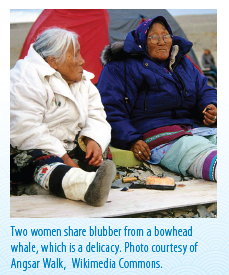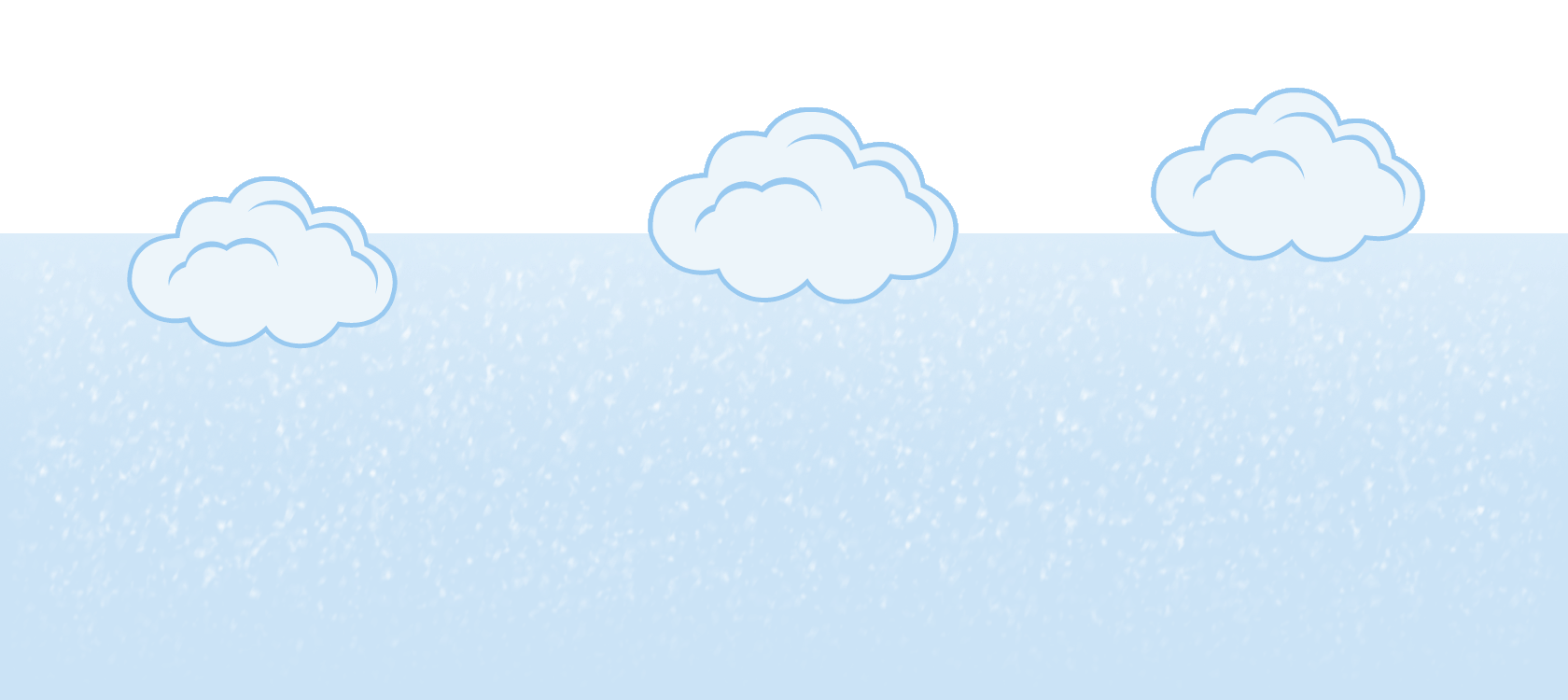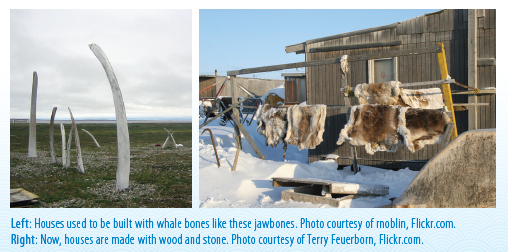 In this informational text, elementary students learn how the Inupiat of Alaska’s Northwest coast have adapted to a changing climate.
In this informational text, elementary students learn how the Inupiat of Alaska’s Northwest coast have adapted to a changing climate.
Versions of this text are available at the K-2 and 3-5 grade bands. The Flesch-Kincaid reading level of each version is provided following the text. Each version is available as a text-only document (a downloadable PDF document), a full-color, illustrated book (downloadable PDF document), and an electronic book with recorded narration. You can use these various versions and formats as you differentiate instruction for your students.
Related resources provide lessons and children’s literature that can be used in conjunction with the text.
Grades K-2
People of the Whale
Original text by Stephen Whitt
Adapted by Jessica Fries-Gaither
Do you know where Alaska is? It is near the top of the world. North of Alaska is the Arctic Ocean.
It is cold. But people live there. They live near the Arctic Ocean. They call themselves the “people of the whale.”
They mean the bowhead whale. It is very special to them.
They hunt the whales every year. When the hunters kill a whale, everyone in the village helps to pull it onto the land. Everyone shares the meat.
The people’s lives have changed in many ways. They used to build their houses with whale bones. Now they have to use wood and stone.
They used to live along the ocean. Now they live farther away.
Hunters from other places used to come on ships and kill too many whales. Then there were not enough whales to hunt. But the ships went away, and now there are more whales again.
The world is getting warmer. The ice on the ocean is melting. This is bad for the whales. They have to be near the ice to find food.
The whales swim farther away from land to eat. This means that the hunters have to travel farther to find the whales. It can be dangerous to go that far to hunt.
Companies want to drill underneath the ocean to find oil. If they do, the whales will go away again. And the people need the whales to live.
What will the “people of the whale” do? How will they live in a warmer world?
Flesch-Kincaid Reading Level = 1.9
Access this Grades K-2 text as a text-only document.
Access this Grades K-2 text as a full-color illustrated book.
Access this Grades K-2 text as an electronic book.
Notes for assembling the illustrated books:
You can put this book together a couple of different ways. You can print out the pages, cut them in half and then order the pages back to front. Fold the stack in half and then staple the spine of the book. Pairs of pages can then be stapled or glued along the right edge.
You can also assemble the book as a foldable book.
To assemble the books this way, print the four pages and align the document pages so that the following book page numbers are in the lower right-hand corner: front page, page 6, page 2, and page 4. (The cover page should be on top and page 4 on the bottom.) Set your copier to copy single pages into double pages and run the four document pages in the order specified. Cut along the dotted line in the center of the double-sided page, place the book pages in order, fold, and staple along the spine.
Grades 3-5
People of the Whale
Original text by Stephen Whitt
Adapted by Jessica Fries-Gaither
A group of Native Americans lives along the coast of Alaska. They are called the Inupiat. Sometimes they call themselves the “people of the whale.” They mean the bowhead whale of the Arctic Ocean.
These people have lived near the Arctic Ocean for hundreds of years. Each year, they waited for the migration of the whales. Then they paddled small boats out into the ocean. They took harpoons made out of stone and bone. They hunted for one of these whales.
When the hunters killed a whale, they brought it back to shore. All the people in the village helped to pull the whale up onto the land. Then they cut up the whale and shared the meat. The jawbones were used to build the walls of houses.
But then whaling ships came from Europe and the United States. They killed many bowhead whales. Soon there were not many whales left. The whaling ships left and the Inupiat stopped hunting for a while. Finally, there were enough whales to hunt again.
Later, rising seawater made the people move farther away from the ocean. This time, they used wood and stone instead of whale bones to build their houses.
Today there are more changes. The world is getting warmer. The ice that covers the Arctic Ocean is melting. The whales are following the shrinking ice to find food. The hunters are following the whales farther away from land. This can be dangerous.
Soon hunting the whales may be even more dangerous. Companies want to explore the ocean. They want to drill for oil where the whales migrate. Then the whales may go even further away from shore. The hunters will have to follow the whales out into the sea.
The people are not giving up. They are learning new ways to hunt. They have always been able to change and survive. They are still the people of the whale.
Glossary
harpoons – spears used in hunting whales and large fish
Flesch-Kincaid Reading Level = 3.5
Access this Grades 3-5 text as a text-only document.
Access this Grades 3-5 text as a full-color illustrated book.
Access this Grades 3-5 text as an electronic book.
Notes for assembling the illustrated books:
You can put this book together a couple of different ways. You can print out the pages, cut them in half and then order the pages back to front. Fold the stack in half and then staple the spine of the book. Pairs of pages can then be stapled or glued along the right edge.
You can also assemble the book as a foldable book.
To assemble the books this way, print the four pages and align the document pages so that the following book page numbers are in the lower right-hand corner: front page, page 6, page 2, and page 4. (The cover page should be on top and page 4 on the bottom.) Set your copier to copy single pages into double pages and run the four document pages in the order specified. Cut along the dotted line in the center of the double-sided page, place the book pages in order, fold, and staple along the spine.
Related Resources
Lessons and Activities about Arctic Peoples
This article from the “Peoples of the Arctic” issue of Beyond Penguins and Polar Bears highlights lessons and activities that can teach students about the Inupiat and other Arctic cultures.
Peoples of the Arctic: Virtual Bookshelf
This article from the “Peoples of the Arctic” issue of Beyond Penguins and Polar Bears highlights children’s literature about the indigenous peoples of the Arctic.
For Alaska’s Inupiat, Climate Change and Culture Shock
This article from Discovery News is a source of background knowledge for teachers whose students are reading “People of the Whale.”
This article was written by Jessica Fries-Gaither. Jessica is an education resource specialist at The Ohio State University and project director of Beyond Weather and the Water Cycle and Beyond Penguins and Polar Bears. She has taught in elementary and middle school settings. Email Jessica at beyondweather@msteacher.org.
The article originally appeared in the Climate Change and the Polar Regions issue of the Beyond Penguins and Polar Bears online magazine. It has been updated from the original.
Copyright February 2012 – The Ohio State University. This material is based upon work supported by the National Science Foundation under Grant No. 1034922. Any opinions, findings, and conclusions or recommendations expressed in this material are those of the author(s) and do not necessarily reflect the views of the National Science Foundation. This work is licensed under an Attribution-ShareAlike 3.0 Unported Creative Commons license.




